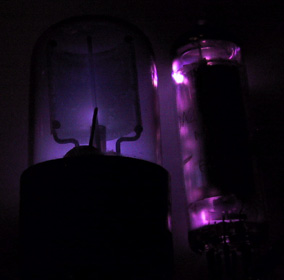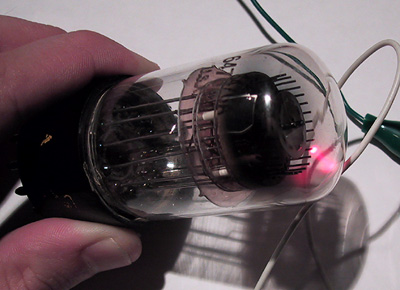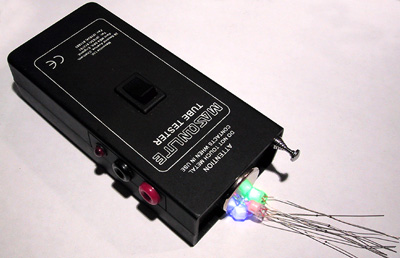How many times have you bought a Nixie tube at a garage sale or swap meet, only to discover once you got home that the tube was outgassed? Obviously there is a definite place for a cold cathode tube tester that is portable and functional. I have seen quite a few "portable" Nixie testers that other people have built, and one common feature of them is that they are huge. Either they have a gigantic lead acid battery for a power source, or they have some complex system that tries to cover the instance where the user would want to test every digit of a tube by means of rotary switches or huge banks of sockets or whatever. There is a way to build a cheap portable tester that will work on Nixie tubes, dekatrons, Panaplex displays, and many other cold cathode tube without requiring complex controls or a vast array of sockets. With a very high voltage, low current supply, one can build a portable ion source that can ionize the gas inside a tube, without even touching the tube. In effect the user ends up with a magic wand that will cause any cold cathode tube in its presence to light up.
There are many prefabricated ion sources available that can be found quite easily, inside laptops. Laptops use high voltage compact fluorescent tubes for their backlights, and the power supplies for these can be easily modified to act as an ion source. A typical laptop CCFL power supply board is capable of generating in excess of a thousand volts from a 5 or 12 volt battery, which makes truly portable testers attainable. For my first ionizer, I used a CCFL supply from an old Powerbook 500, of which I had a whole sack of. Unless the pins on the supply are labeled, you will need to do some random voltage application to figure out where to connect the input power. This process is greatly enhanced if a backlight is available to indicate when the supply has been correctly hooked up. Most laptop backlights are interchangeable; I used a backlight out of a DEC laptop that had been crushed by a salvage company.

Once you have the input power pins identified, it is time to hook up the output. As you can see from the picture above, the voltage is high enough that the electric current will jump through a decent amount of open air. For this reason, you will want to use a wire with thick insulation at the point where the output connects to the circuit board, otherwise the voltage will just jump the gap between the two pins. You will want to attach about six inches of wire to one of the output pins to act as a probe, leave the other pin disconnected. Stuff the whole thing and a case of some sort (PVC pipe will work well), and drill a hole in one end to trail the probe out of. With a nine volt battery or a couple of AA cells thrown in, you will have a portable cold cathode tester that will leave swap-meet vendors thinking twice about selling you outgassed tubes.

Here is a picture of my first ionizer being used to test a 0A2 and a 1P40 for outgassing. Its also possible to test individual digits in a Nixie tube, by touching the pin for the digit being tested. This provides enough of a ground that the glow from the ion generator will be attracted to that digit. In the picture below, you can see me performing this type of test on one of the cathode pins of a selector dekatron. The white wire at the right side of the picture is the probe.

Shortly after I made the ion generator above, I discovered that there was a better, more powerful commercial solution. Buried amongst a pile of test equipment at a garage sale, I discovered this device.

It's a Masonlite Tube Tester, a portable ion generator designed to test fluorescent light fixtures. It is both more powerful and more convenient than the homemade ionizer I built. It also has a place to attach leads to test items directly, and an extendible antenna to test fluorescent tubes that are still installed in their fixtures. The antenna also makes the device look a lot like a remote detonator from a James Bond movie, so I would not try to use it in an airport unless you enjoy being tackled by burly security personnel. Unless you stumble across one at a garage sale for ten dollars like I did though, a homemade ionizer is likely to be a far cheaper and more practical choice.
A sidenote, I took the picture above right after I discovered that there was such a thing as a blue neon lamp. I am still getting used to the idea that it is possible to buy neon bulbs in colors other than orange!






